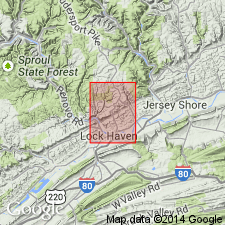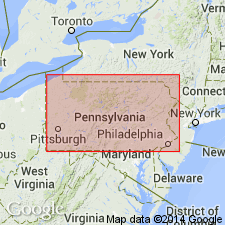
- Usage in publication:
-
- Lock Haven Formation
- Modifications:
-
- Named
- Dominant lithology:
-
- Shale
- Siltstone
- Sandstone
- AAPG geologic province:
-
- Appalachian basin
Summary:
Lock Haven Formation here named in Clinton Co., PA. Consists of gray interbedded shale, siltstone, sandstone, and minor conglomerate. Sandstone described as lenticular and cross-bedded. Unit is fossiliferous marine deposit. Gradationally and conformably overlies Brallier Formation; conformably underlies Irish Valley Member of Catskill Formation. Age is Late Devonian.
Source: GNU records (USGS DDS-6; Reston GNULEX).

- Usage in publication:
-
- Lock Haven Formation*
- Modifications:
-
- Revised
- AAPG geologic province:
-
- Appalachian basin
Summary:
Lock Haven Formation of Faill and Wells (1977) adopted for use by the U.S.G.S. and assigned as one of four formations to the Susquehanna Group. Replaces part or most of rocks formerly included in Chemung Formation (now abandoned in PA). Overlies Brallier Formation and underlies Catskill Formation, both of Susquehanna Group.
Source: GNU records (USGS DDS-6; Reston GNULEX).

- Usage in publication:
-
- Lock Haven Formation
- Modifications:
-
- Revised
- AAPG geologic province:
-
- Appalachian basin
Summary:
In north-central PA, Lock Haven Formation is divided into a lower shaly member and an upper sandy member. Lower shaly member correlates with the West Falls (Rhinestreet) onlap sequence of NY and the Scherr Formation and Mallow Member of the Foreknobs Formation of south-central PA. Upper sandy member correlates with the Java and Canadaway offlap sequence of NY and the Briery Gap, Blizzard, Pound, and Red Lick Members of the Foreknobs Formation of south-central PA. The Minnehaha Springs Siltstone Member is recognized in the lower Lock Haven of north-central PA and is herein proposed to mark the base of that formation. [Susquehanna Group not used.]
Source: GNU records (USGS DDS-6; Reston GNULEX).
For more information, please contact Nancy Stamm, Geologic Names Committee Secretary.
Asterisk (*) indicates published by U.S. Geological Survey authors.
"No current usage" (†) implies that a name has been abandoned or has fallen into disuse. Former usage and, if known, replacement name given in parentheses ( ).
Slash (/) indicates name conflicts with nomenclatural guidelines (CSN, 1933; ACSN, 1961, 1970; NACSN, 1983, 2005, 2021). May be explained within brackets ([ ]).

